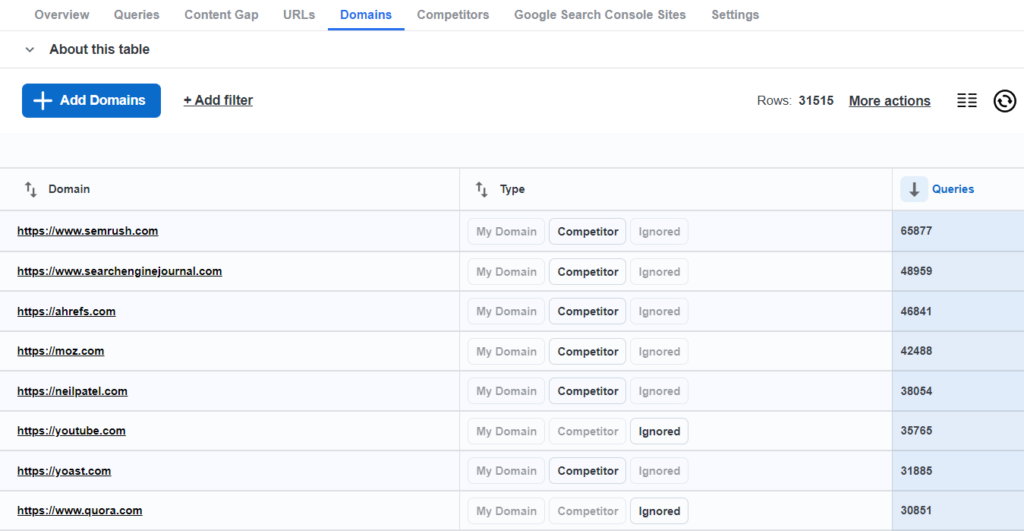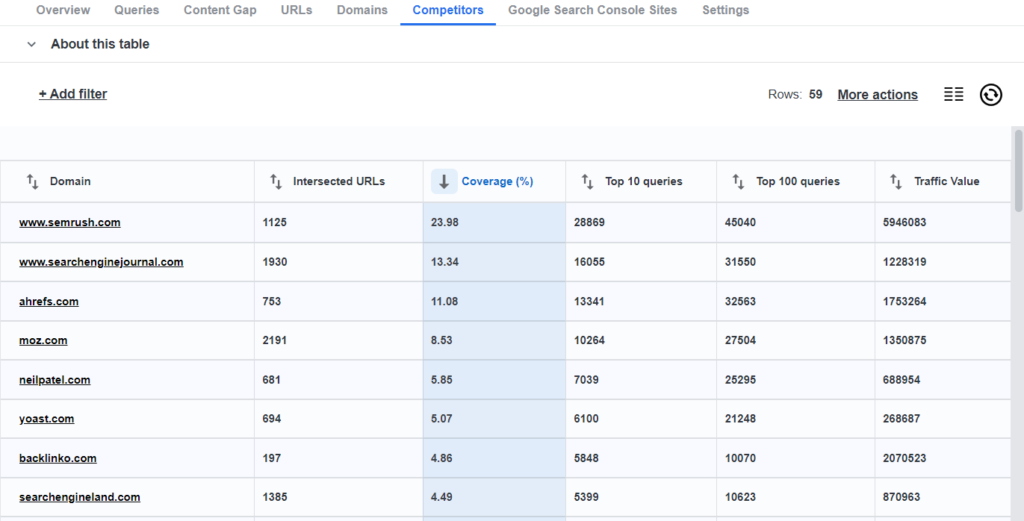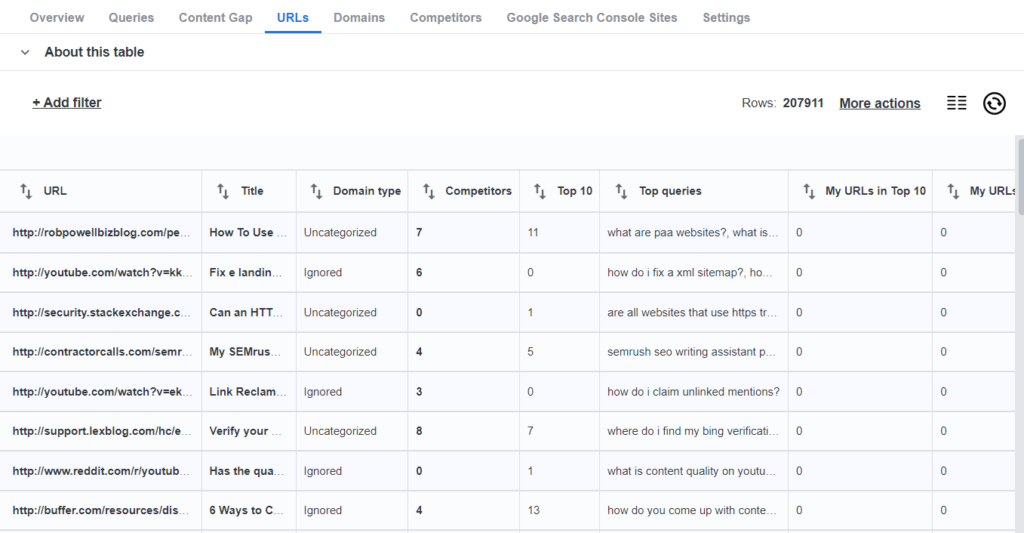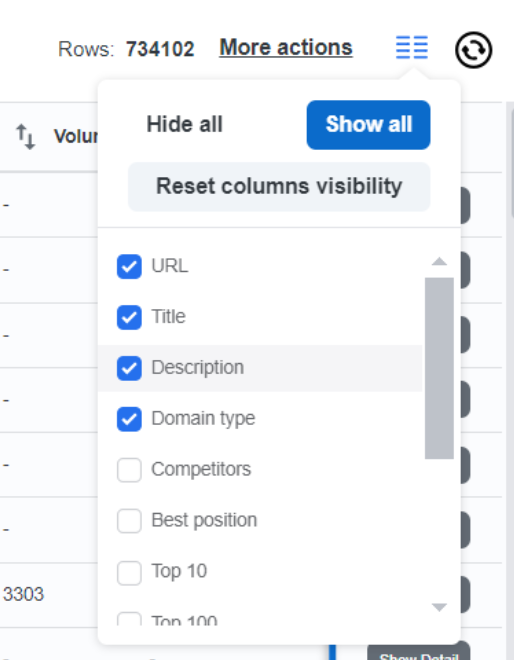The Competitors and URLs features in SEO tools allow you to compare your domain with those of your competitors and analyze the potential significance of your URLs in SERP rankings. By assigning a domain type to competitors’ domains and examining the number of intersecting URLs for specific queries, you can gain valuable insights into your website’s performance and potential areas for improvement.
What are Competitors and URLs features?
Both Competitors and URLs features are part of URLsLab’s SEO insights, and their functions are related. These features analyze and compare URLs and domains in relation to search engine rankings (SERP), providing insights into how your website compares to competitors regarding search visibility. By examining the top 100 URLs and comparing domains, you can gain valuable information on keyword overlap, competitor strategies, and areas for improvement to enhance search rankings and online presence.
How it works?
At the very beginning, categorize these domains to identify your direct competitors and your own domains. This classification enhances the accuracy of other reports in the SEO insights module.

Our tip: Sort the domains according to the number of queries. This way, you will get the most relevant results for potential content optimization.
Then go to the Competitors section. Begin by comparing your domain with those of your competitors. Start by categorizing the domains under the Domains tab based on their type. Evaluate only the URLs from each domain that coincide with particular queries from competitors.

A domain’s coverage is calculated by dividing the total number of URLs in the top ten rankings by the number of queries in the top ten rankings for all URLs in our database. It is important to note that only URLs acquired during SERP query processing are included in this calculation. Enhancing the accuracy of your domain comparison data can be achieved by authorizing more queries for processing in your settings.
Once you specified the domains, you can explore the key queries for your content in section URLs.

The table showcases URLs that rank within the top 100 results on the SERP. Adjacent to each URL, you can explore the key queries linked to it and the amount of competitor domains sharing the same keywords.
The higher the overlap between your URL and those of your competitors, the more significant it may be for your business. Additionally, this report offers insights from your competitors’ websites regarding the characteristics of a well-ranked page, serving as a source of inspiration to pinpoint any content gaps on your own site.
What are the benefits of URLsLab’s Competitors and URLs feature?
- Enhanced Competitor Analysis – By utilizing these features to compare your website’s URLs and domains with those of your competitors, you can gain valuable insights into their strategies and performance in search engine rankings. This information allows you to identify areas where your competitors may be outperforming you, helping you strategize and optimize your own content and SEO tactics to stay competitive in the market.
- Improved Search Engine Visibility – Analyzing the URLs that rank in the top 100 results and assessing your domain’s performance in relation to specific queries provides you with essential data on keyword overlap and search visibility. This insight enables you to fine-tune your keyword targeting, optimize your content, and strengthen your online presence to increase your chances of ranking higher in search engine results pages (SERPs) and attracting more organic traffic to your website.
- Strategic Content Development – By examining competitor websites and understanding what successful, well-ranked pages look like, you can gain inspiration and ideas for enhancing your own content. This can help you identify gaps in your current content strategy and develop tailored, high-quality content that resonates with your target audience and aligns with search engine algorithms, ultimately driving better engagement, conversions, and overall digital marketing success.
Tips to use the Competitors and URLs features
Activate Title and Description column
URLsLab offers various data displayed in columns. What might help you is to display the Title and Description – this way, you will ultimately get insights and an overview of relevant titles and descriptions used.

Review queries properly
All these insights will help you in content optimization, but it is not recommended to take every query of your competitor as something you must have in your content as well. Therefore, always make sure the query is relevant not only for your content strategy and SEO efforts but also for your product or offer itself. Find a way to connect the query to your business and persuade the customer to take a certain action.
Expand the possibilities of queries
Take concrete queries and search for more possibilities and keywords cluster in the section Queries. Such an action will help you organize keywords for your content.
URL Monitoring is crucial for enhanced visibility, streamlined link management, error detection, and SEO optimization. It provides valuable insights and tools to improve website performance and user experience. With features like link validation and customized link text fragments, it's a game-changer for website owners and marketers.
The URLsLab Search and Replace module offers efficient and automated content management for website maintenance. It allows for mass-replacement of URLs and content, ensuring accuracy and time-saving benefits. The module can be used for various purposes, such as website rebranding, content updates, fixing broken links, and implementing SEO keywords. With a user-friendly interface and the ability to revert changes, it is a valuable tool for website management.
Automate Customer Support and improve SEO
The URLsLab WordPress plugin offers AI-powered content generation, SEO automation, and user experience enhancement. It also optimizes media and provides links and image management. Download the plugin now to improve your website.
Link Building is a powerful WordPress module that helps manage keywords, optimize content, and enhance SEO performance. It offers efficient tracking and replacement of keywords, making it suitable for all websites. With features like multilingual website optimization and avoiding keyword stuffing, it empowers users to take control of their SEO strategy.
URL Monitoring is crucial for enhanced visibility, streamlined link management, error detection, and SEO optimization. It provides valuable insights and tools to improve website performance and user experience. With features like link validation and customized link text fragments, it's a game-changer for website owners and marketers.
The URLsLab Search and Replace module offers efficient and automated content management for website maintenance. It allows for mass-replacement of URLs and content, ensuring accuracy and time-saving benefits. The module can be used for various purposes, such as website rebranding, content updates, fixing broken links, and implementing SEO keywords. With a user-friendly interface and the ability to revert changes, it is a valuable tool for website management.

